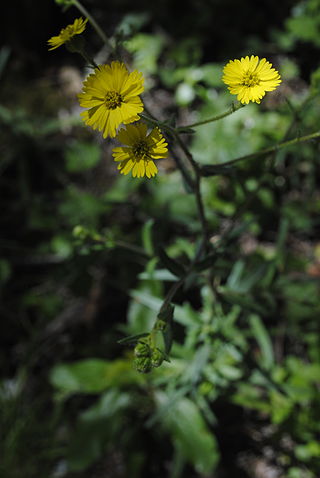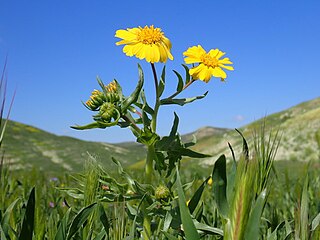
Madia is a genus of annual or perennial usually aromatic herbs with yellow flowers, in the tribe Madieae within the family Asteraceae.

Madia elegans is an annual herbaceous plant species in the family Asteraceae. It is generally known as the common madia, but there are several subspecies known by various common names.

Ericameria discoidea, commonly known as whitestem goldenbush or sharp-scale goldenweed is a species of flowering shrub in the family Asteraceae. This plant is native to the western United States from California, Oregon, Nevada, Utah, Colorado, Idaho, and Montana.

Symphyotrichum campestre is a species of flowering plant of the family Asteraceae commonly known as western meadow aster. It is native to much of western North America where it grows in many habitats, generally at some elevation.

Holocarpha heermannii is a species of flowering plant in the family Asteraceae known by the common name Heermann's tarweed. It is endemic to California.

Holocarpha virgata is a species of flowering plant in the family Asteraceae known by the common names yellowflower tarweed, pitgland tarweed, and narrow tarplant.
Madia anomala is a species of flowering plant in the family Asteraceae known by the common name plumpseeded madia. It is endemic to northern California, where it can be found on hillsides in the San Francisco Bay Area and adjacent mountains and valleys.

Kyhosia is a monotypic genus of flowering plants in the family Asteraceae containing the single species Kyhosia bolanderi, which is known by the common names Bolander's madia and kyhosia.

Madia exigua is a species of flowering plant in the family Asteraceae known by the common names small tarweed and threadstem madia.

Madia glomerata is a species of flowering plant in the family Asteraceae known by the common name mountain tarweed.

Anisocarpus madioides is a North American species of flowering plant in the family Asteraceae known by the common name woodland madia.

Madia radiata is a species of flowering plant in the family Asteraceae known by the common names golden madia and showy madia. It is endemic to California, where it is known mostly from the Central Coast Ranges and adjacent edges of the San Francisco Bay Area and Central Valley.

Madia sativa, known by the common names coast tarweed and Chilean tarweed, is a species of flowering plant in the family Asteraceae found in parts of western North and South America.

Harmonia stebbinsii is a species of flowering plant in the family Asteraceae known by the common name Stebbins' tarweed, or Stebbins' madia. It is endemic to northern California, where it is limited to the Klamath Mountains and adjacent slopes of the North Coast Ranges. It is a member of the serpentine soils plant community in these mountains, found at elevations of 1100–1600 meters. It is a rare annual herb producing a bristly stem up to about 25 centimeters tall studded with black resin glands. Its bristly leaves grow up to about 2 centimeters long and are mostly gathered near the base of the plant. The inflorescence is an array of flower heads lined with hairy, glandular, purple-tipped phyllaries. The head has a few yellow ray florets several millimeters long and yellow disc florets. The fruit is an achene tipped with a pappus.

Arnica dealbata is a species of Californian plants in the tarweed tribe within the aster family
Harmonia guggolziorum is a rare California plant species of plant in the tribe Madieae within the family Asteraceae. It is known by the common names Guggolz tarplant and Guggolzes' harmonia. It is endemic to Mendocino County, California, where it is known from two occurrences near Hopland. It is a member of the serpentine soils flora and grows in chaparral habitat. It was only discovered in 2000 and described to science in 2001.

Deinandra conjugens is a rare species of flowering plant in the family Asteraceae known by the common names Otay tarplant and Otay tarweed. It is native to a small section of far northern Baja California in Mexico, its range extending north into San Diego County, California, in the United States. One isolated population has been reported from the hills east of Cayucos in San Luis Obispo County.

Deinandra increscens is a species of flowering plant in the family Asteraceae known by the common name grassland tarweed. It is endemic to California, where it has been found primarily in Monterey, San Luis Obispo and Santa Barbara Counties. A few isolated populations have been reported from Kern and Merced Counties, but these are from urban areas and probably represent cultivated specimens.

Deinandra mohavensis, commonly known as Mojave tarplant or Mojave tarweed, is a species of flowering plant in the family Asteraceae.

Centromadia pungens, the common spikeweed or common tarweed, is a species of North American plants in the tribe Madieae within the family Asteraceae. It is native to northern Baja California and the western United States. The plant is considered a noxious weed in parts of the Pacific Northwest.



















